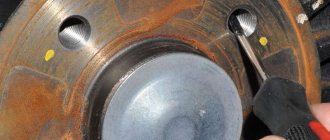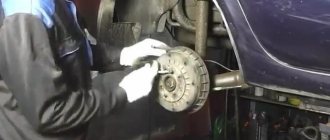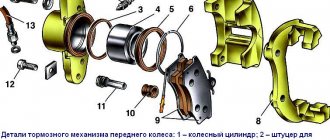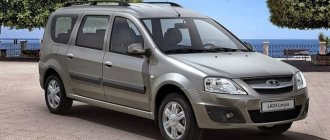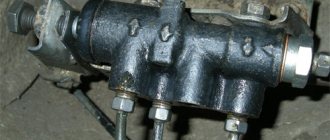We replace the pads of a Lada Largus car in case of maximum permissible wear of their linings - the minimum thickness of the pad, including its base, must be at least 6 mm. The pads also need to be replaced when the brake disc is replaced, the linings are oily or have deep grooves, cracks and chips on them, as well as when the linings detach from the base of the pads.
We carry out the work on a flat area, inspection ditch or overpass.
Attention! The brake pads of the front wheels must be replaced only as a set - all four pads. Replacing the pads of only one brake mechanism can lead to the car pulling to the side when braking.
If the fluid level in the hydraulic brake reservoir is at the MAX mark, then before installing new pads, use a syringe or rubber bulb to pump out some of the fluid from the reservoir. This operation must be performed so that when the piston is pressed into the wheel cylinder of the brake mechanism while installing new pads, fluid does not flow out from under the reservoir cap.
We remove the front wheel and securely fix the car on a factory-made support stand. Before installing new pads, it is necessary to move the wheel cylinder piston as much as possible inside the cylinder.
2283-14-02-01 (Copy)
To do this, insert a screwdriver with a wide blade through the hole in the caliper between the brake disc and the caliper and rest it on the caliper, move the bracket, recessing the piston into the cylinder.
To do this, insert a screwdriver with a wide blade through the hole in the caliper between the brake disc and the caliper and rest it on the caliper, move the bracket, recessing the piston into the cylinder.
To do this, insert a screwdriver with a wide blade through the hole in the caliper between the brake disc and the caliper and rest it on the caliper, move the bracket, recessing the piston into the cylinder.
Types of brakes
In the automotive industry there are three main categories of brake mechanisms installed as standard:
- strip structures;
- drum systems;
- disc brakes.
The first “instances” at the dawn of the automobile industry had band brakes. This product covered the entire perimeter of the wheel rim, which allowed the driver to direct the braking force there at a certain moment. He could only pull the tape, which led to the slowdown of the “cart”.
Evolution has done its progressive work, and the outdated “ribbons” were replaced by drums, as in the Lada Largus. The principle of their operation was not intricate, but involved free rotation of the wheel paired with a drum, which, by expanding the pads present in its cavity, received the braking force, causing the car to slow down. This concept worked quite well, but over time some of its shortcomings became apparent. Here the intensity of the drum system has a special influence. The design is closed, and the pads overheat very quickly, which directly affects the deterioration of the braking effect. Along with excessive heating, moisture ingress turned out to be detrimental to the drum mechanism. The presence of water and dirt inside the assembly causes a decrease in performance. It is also not uncommon for a part to break inside a closed drum mechanism. On the one hand, the noise that appears will provide the driver with information about the breakdown that has occurred, and on the other hand, it can provoke damage to the internal working area of the drum itself.
The disc brakes installed in Lada Largus have proven to be the most reliable. In them, all the shortcomings inherent in the previous categories are completely leveled out. The operating principle is as follows. Paired with the wheel, the brake disc itself rotates until it is subjected to the compressive force of the pads. This action is possible by moving the brake rod from the cavity of the hydraulic cylinder present in the caliper. The disc uses a ventilation system that allows you to effectively cool the working area during intensive braking. Note that in the vast majority of cars only the front mechanisms are ventilated. Also, the fact that moisture gets on the disk cannot cause significant damage, since it dries quickly, and the remaining debris is spontaneously removed by centrifugal force. Although there are frequent cases of disc distortion due to frequent alternation of overheating and the passage of water “obstacles” (puddles). The disk mechanism better tolerates loads, so the entire system is as efficient as possible.
Due to the significantly lower cost of drum assemblies compared to disk counterparts, many manufacturers in their budget models resort to a combination of mechanisms, with disks in front and drums in the rear.
2283-14-02-02 (Copy)
Using a 13mm spanner, unscrew the bolt securing the bracket to the lower guide pin, holding the pin with a 15mm spanner.
Using a 13mm spanner, unscrew the bolt securing the bracket to the lower guide pin, holding the pin with a 15mm spanner.
Using a 13mm spanner, unscrew the bolt securing the bracket to the lower guide pin, holding the pin with a 15mm spanner.
What types of brakes are there?
Throughout the history of the automotive industry, 3 types of brakes have been installed on cars:
- tape;
- drums;
- disk.
The first cars had a band brake system. The wheel axle was covered with tape. The driver had access to it at any time. If he needed to slow down, he pulled the tape, and this allowed him to reduce the speed.
Through “evolution,” the band brake was replaced by a drum mechanism. The principle of operation is the simultaneous rotation of a hollow drum with a wheel, which is bursting inside with pads. This slows down the car. This type of brake has proven itself well, but it also has disadvantages. With frequent heavy use, the drum overheats, since the ventilation in this closed system is not the same as that of a disk mechanism.
Just like overheating, moisture getting into the mechanism is also harmful to the drum. When individual parts become wet, the effectiveness of the brakes decreases. If any part in the drum wears out or falls off, it remains inside the system. This is both a minus and a plus. Indeed, in this case, the driver will hear a knock, and it will be possible to take measures to replace the part.
The disc brake system is the most reliable mechanism that eliminates the above-mentioned disadvantages of previous systems. Disc brakes work by rotating the disc simultaneously with the wheel, and when you press the brake pedal, the pads jam the rotation of the disc from the outside. Unlike the drum, the disc is ventilated, so it is less susceptible to overheating than the drum. The discs do not retain moisture and damaged parts. The operating principle of this system is based on the ability to work under heavy loads. Therefore, you can stop your car faster with disc brakes.
Such mechanisms are often front-facing and ventilated. Ventilation holes cover the entire radius of the disc. Some modifications have transverse ventilation holes. With their help, excess heat is removed, weight is reduced and worn parts are removed.
Due to the fact that the drum mechanism costs much less than the disk mechanism, today both disks and drums are used.
Return to contents
2283-14-02-05 (Copy)
Remove the two spring clamps of the pads.
Remove the two spring clamps of the pads.
Remove the two spring clamps of the pads.
Using a metal brush, we clean the spring brackets and pad seats in their guide from dirt and corrosion.
Before installing new pads, we check the condition of the protective covers of the guide pins. We replace the torn or lost elasticity cover.
All services for Lada Largus
- Body repair Lada Largus Body repair Lada Largus
- Repair of front bumper Lada Largus
- Lada Largus radiator grille repair
- Lada Largus rear bumper repair
- Lada Largus door repair
- Lada Largus hood repair
- Repair of the front fender of Lada Largus
- Repair of rear wing of Lada Largus
- Lada Largus trunk door repair
- Lada Largus trunk lid repair
- Lada Largus roof repair
- Lada Largus body repair
- Lada Largus frame repair
- Repair of the front side member of Lada Largus
- Repair of rear side member of Lada Largus
- Lada Largus threshold repair
- Lada Largus side mirror repair
- Painting Lada Largus
- Mechanical repair of Lada Largus
- Maintenance service Lada Largus
2283-14-02-06 (Copy)
To do this, remove the guide pin from the hole in the guide block and replace the cover.
To do this, remove the guide pin from the hole in the guide block and replace the cover.
To do this, remove the guide pin from the hole in the guide block and replace the cover.
To replace the upper guide pin cover, you need to unscrew the bolt securing the bracket to the pin and remove the bracket from the pad guide.
Before installing the pin, put a little grease into the hole in the pad guide.
How to remove and replace a brake disc on a Lada Largus
So, the first thing you need to do is remove the wheel bolts, and then jack up the front of the car. Next, remove the wheel and caliper assembly. After this, you can begin to carry out this repair directly.
For greater clarity, it is worth looking at the report below.
Video review of replacing brake discs on Largus
The video clip below is embedded from my YouTube channel, so it’s better to first familiarize yourself with it, and only then carefully read the article itself. Well, below everything will be presented in standard form.
Photo report of the work done on removing and installing brake discs on Largus
So, when the caliper is removed and nothing else bothers us, we need to unscrew the two screws that secure the disc to the hub using a torx t 40 bit.
2283-14-02-08 (Copy)
If the part of the piston protruding from the wheel cylinder prevents the installation of the caliper on the brake pads, then use sliding pliers to recess the piston into the cylinder.
If the part of the piston protruding from the wheel cylinder prevents the installation of the caliper on the brake pads, then use sliding pliers to recess the piston into the cylinder.
If the part of the piston protruding from the wheel cylinder prevents the installation of the caliper on the brake pads, then use sliding pliers to recess the piston into the cylinder.
Similarly, we replace the pads on the other side of the Lada Largus car. After replacing the pads, press the brake pedal several times to set the gaps between the pads and discs. We check the fluid level in the tank and, if necessary, bring it up to normal.
During operation, the surface of the brake disc becomes uneven, as a result of which the contact area of the new, not yet worn-in pads with the disc decreases. Therefore, during the first 100 km after replacing the pads, until the new pads have broken in, be careful, as the car’s braking distance may increase. In this case, the pads may become hotter than usual, up to the appearance of slight smoke and odor, especially in hot weather.
[How to save on maintenance of Lada Largus] [Maintenance of Lada Largus at 15,000/45,000/75,000/105,000 km] [Maintenance of Lada Largus at 30 thousand km] [Maintenance of Lada Largus at 60 thousand km of run] [Maintenance of Lada Largus for 90 thousand km of run] [Maintenance of Lada Largus for 120 thousand km of run] [Independent maintenance - general recommendations] [Safety rules for self-carrying out maintenance] [Tools required for carrying out maintenance Lada Largus maintenance] [Lamps used in the Lada Largus car]
Lada Largus: replacing the brake pads of the front wheels
Choosing pads
It is recommended to change the pads when their thickness is less than 6 mm. At this moment, many Largus drivers who change pads for the first time ask themselves: what kind of pads do I have in my car? And they immediately go to the Internet for information. And here additional questions arise. Online stores sell pads for engines with 8 and 16 valves, as well as with and without ABS. Which pads to take, which ones are better? In order not to be overwhelmed with the choice, do not be too lazy to remove the wheel, clean the dirt from the pads and find the serial number on them, which should be used as a guide when purchasing. Better yet, check the numbers on all wheels.
According to the catalog, the Lada Largus comes with two types of original pads:
Number 410608481R, look like this:
Number 410602192R, they look like this:
It is not recommended to install pads 410602219R on an 8-valve engine, since they are used on 16-valve internal combustion engines and on the Largus van.
Recommended analogues:
- SANGSIN SP1243 – made in Korea.
- BOSCH 986467720.
- TRW GDB1465.
Required Tools
Replacing front pads is not a job that is performed exclusively in a car service center. With a minimum of technical knowledge, a certain amount of patience and an hour of free time, almost every car enthusiast can cope with the task.
List of required tools:
- head or “star” at 13;
- open-end wrench 15;
- wheel wrench;
- jack;
- powerful flat screwdriver;
- a tube of lubricant for brake system parts;
- metal brush.
Replacement procedure
First of all, drivers should know that such pads are replaced in pairs. Experts do not recommend doing this separately, because this can lead to destabilization of the entire car during a gradual or sudden stop. However, only the front elements of the system of the same name require frequent attention, although in many ways everything is justified by a specific malfunction.
Step one
The procedure for replacing the pads is carried out only in a set of 4 parts, 2 pieces on each side. First of all, you should check the brake fluid level in the tank of the corresponding cylinder. If it approaches the maximum, then the fluid needs to be pumped out, because after installing new pads this level rises significantly.
Step two
Next, the wheel bolts are loosened, from which the replacement of the pads begins. The corresponding part of the car is raised with a jack, reliable supports are installed and the wheel itself is removed. Using a screwdriver, the existing pads are removed from the disk, that is, the piston is pressed all the way into the bottom of the working cylinder.
Purchase and delivery methods
The Auto-Tech enterprise is located in Moscow, you can purchase goods right here at the point. However, the site delivers throughout the region, as well as throughout Russia . Any region of the country has not been left without attention, so the location of your location does not matter when ordering products.
A special pride and clear advantage of the company is their ability to quickly and on time deliver the ordered batch. The store cooperates with some trusted transport companies. Among them are “Pack” and “Business Lines”.
Well-functioning logistics is a necessity if you want to please your customers so that they can receive the goods exactly when they need them.
The price range of brake pads in the list starts from 441 rubles. up to 1,530 rub. for packaging for Lada Largus cars. If you have any questions, please contact our staff at the phone number listed on the main website.
Good day.
When changing tires from winter to summer, I noticed the wear of the brake disc. The wear is not great, but considering the mileage of 9500 km, the wear is simply enormous. On the forums, many are inclined to believe that the original pads are very hard and to reduce disc wear they install softer ones, such as Ferodo FDB1617
Recommendations after the replacement procedure
Having installed new parts, there is no need to hastily go to busy road junctions to test them in practice. It is possible that the first time the brake pedal is pressed firmly, the driver will be surprised by the low efficiency of its response. Even if the pads are of the high quality announced by the manufacturer, the situation may be unpredictable.
This is explained by the accompanying wear of the discs of the same name, which come into contact with the new pads only at the edges, almost without braking. It is best to choose quiet streets and try to slow down smoothly several times. So, all the parts will be able to “grind in” over the entire surface. At the same time, you can evaluate the effectiveness of new elements of the braking system.
Initially, you need to try not to stop abruptly for at least the first 100 km, because with strong heating, the top layer of the new pads heats up, and the brakes will not immediately be able to be as effective as possible.
Let's sum it up
Since the LADA Largus brake system has a significant impact on traffic safety, the elements require increased attention and timely replacement of the front brake pads. It is not recommended to allow excessive wear of the working surfaces. The specified consumables that have become unusable must be replaced immediately. Buy only products of decent quality, which will allow you to gain confidence in the stable operation of the brake unit only in normal mode, but also in emergency situations.
- https://avtonomnaya-gazifikaciya.ru/priora/zamena-perednih-kolodok-na-larguse.html
- https://ZamenaRenault.ru/largus/elektrika-i-tormoza/zadnie-kolodki.html
- https://ZamenaRenault.ru/largus/elektrika-i-tormoza/kolodki-tormoznye-perednie.html
- https://carfrance.ru/zamena-perednix-tormoznyx-kolodok-na-lada-largus-svoimi-rukami-artikuly-s-abs-i-bez/
- https://ladaevolution.ru/zamena-kolodok-lada-largus-svoimi-rukami-poshagovaja-instrukcija/
- https://el-guide.ru/remont/zamena-kolodok-na-larguse-16-klapannom.html
- https://LargusCenter.ru/remont/zamena-tormoznyih-kolodok-largus.html
- https://oootdssk.ru/zamena-zadnih-kolodok-largus/


